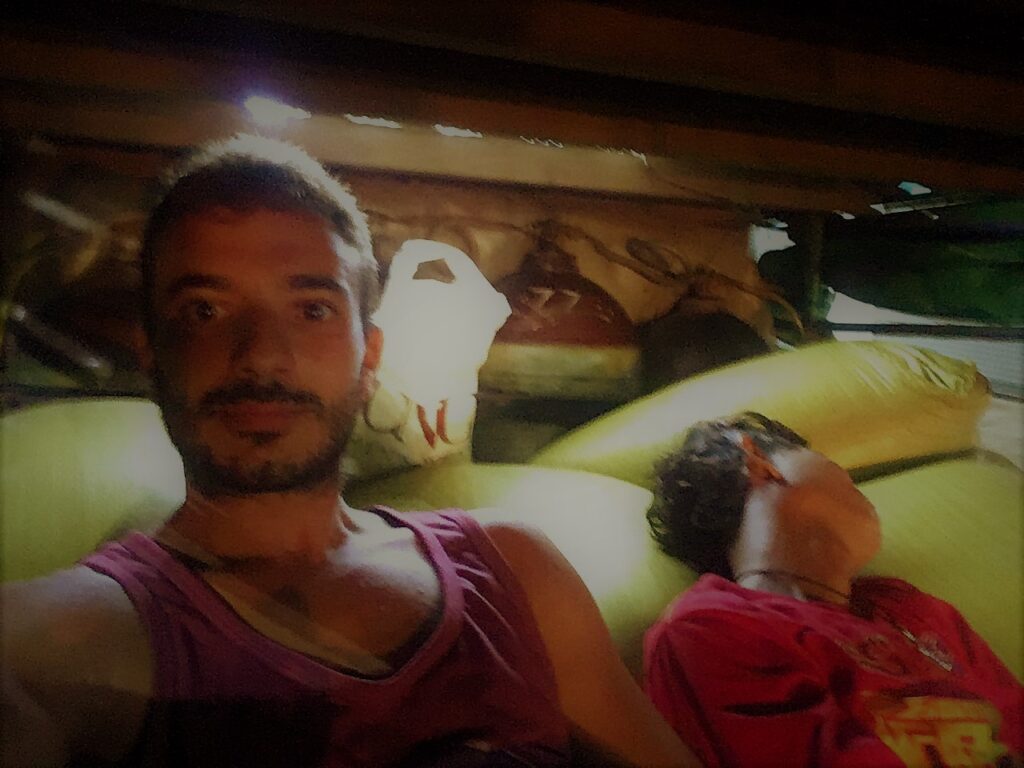As you might remember, my 2 days in Yangon had just come to an end. After some research and hesitation, I decided that my next destination would be Hpa-An, but, on the way, I would stop in Bago. I asked one of the guys working at the hostel and he let me know about the timetable of the train from Yangon to Bago. It seems that route is becoming more popular and nowadays you can even take a look at the train timetable yourself :). Thus, after leaving Backpacker Hostel behind, I walked to Yangon Central Railway Station. Next stop: a visit to Bago.
How to get from Yangon to Bago?
When it comes to public transport, there are basically two ways to go to Bago: by train or by bus. In my case, after speaking to the people at Backpacker Hotel, I decided I would take the train. To that extend, I needed to walk to Yangon Central Railway Station and buy my ticket there. As of today, it seems you can even buy it online. Prices vary depending on the type of ticket. Upper-class costs around 15000 MMK while ordinary-class costs as little as 600 MMK (which is what I paid). The train takes around 1 hour and 45 minutes. It follows a more direct route than by road by following the course of Bago river and the scenery is more beautiful.
If you want to go by bus, the trip takes around 30 to 40 minutes more than by train. To buy your ticket, you may want to check with your hostel first. Throughout my 3 weeks in Myanmar, I bought most of my bus tickets at the hostel I was staying at. Not sure if, as with the train ticket, you can also buy it online. For sure, you can buy it at the bus station. The only “problem” is that, in this case, both bus stations are kind of far away from Yangon city centre. You need to go to either Saw Bwar Gyi Gone (located near the airport) or to Aung Mingalar, which is 20km away from the city centre. Prices at both stations should be similar: around 2000 MMK.
Train ride from Yangon to Bago
As I was saying, one of the good things about going to Bago by train is that you can easily (and quickly) make it to Yangon Central Railway Station. From Backpacker Hostel there were just 2 km. Thus, I could arrive at the station with enough time, or that’s what I thought.
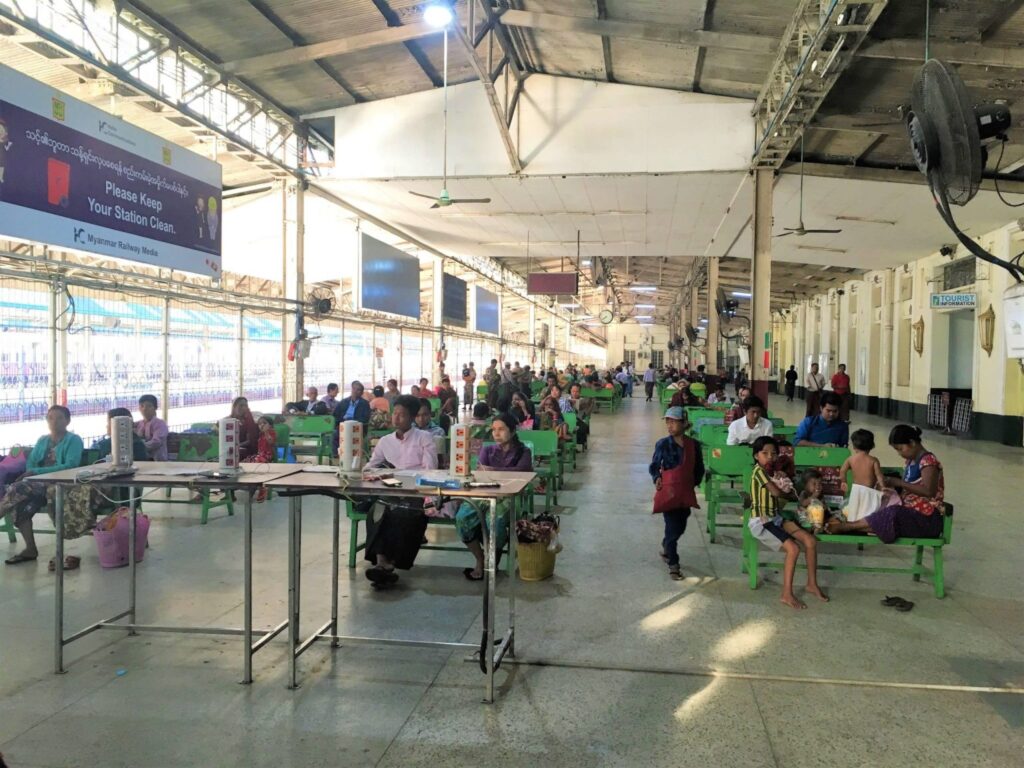
I was one of the first on the line to buy the ticket to Bago, but the ticket sellers were extremely slow, and I really mean it. They were so slow that an old local man almost tried to do the paperwork himself lol. I spent around 20 minutes waiting for them to fill out the information on the ticket. All the upper-class tickets were sold out so I bought an ordinary-class for 600 MMK (around 0.40 Euros). I got onto my coach just a couple of minutes before the train left.
As during my ride in Yangon Circular Train, most of the people I saw were locals. The seats were made out of wood and, while they were not the most comfortable in the world, I couldn’t complain after having paid what I paid 😅. The windows had a pretty peculiar closing system, like if we were inside a container. This time, the train was mostly used to carry people to their destination, and not as a market. Nonetheless, you could always find someone selling some sort of snacks.
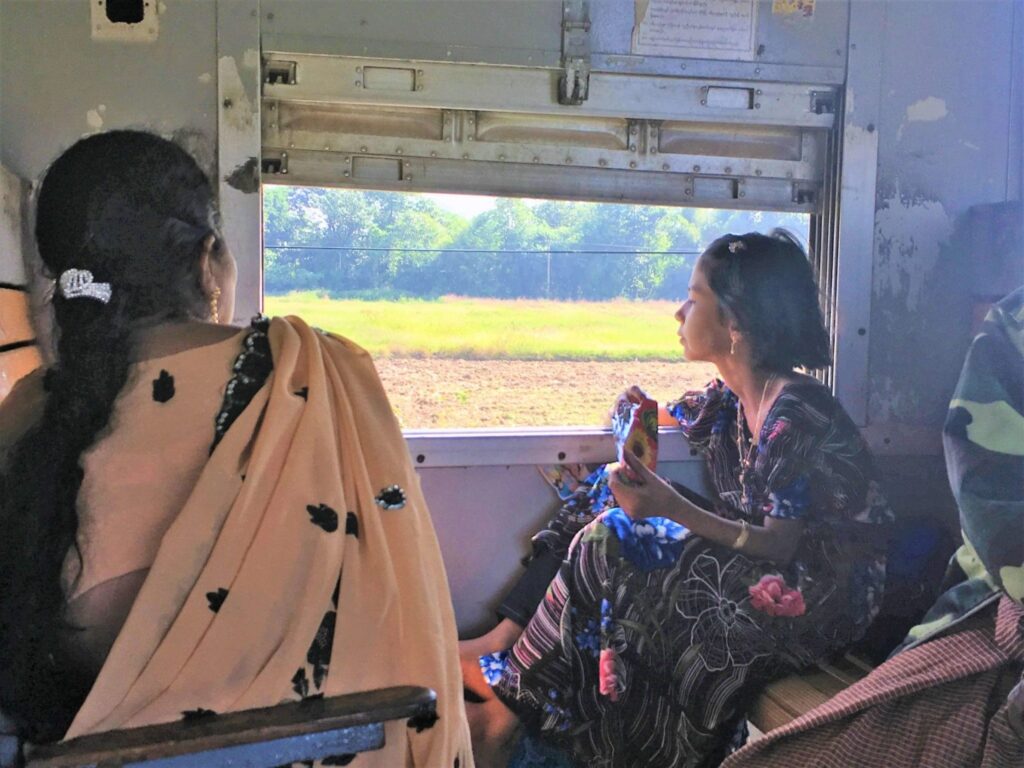
I liked the landscape better than the one around Yangon. There were not sign of towns, but just fields, animals and some pagodas. It gave me a feeling of peace and relaxation and I switched from staring at the landscape to reading my recently acquired “Finding George Orwell in Burma”. What else can you ask for? 🙂

What to see in Bago?
After a couple of hours the train arrived at Bago Station. I was looking forward to visit Bago but I wasn’t sure about how to do it. I didn’t even know how to come out from the station, which looked like anything but a train station lol.
As I was standing there trying to make up my mind, a local guy approached me. He was riding a motorbike and asked me if I wanted to go on a tour around Bago with him. His English was not the best but, after a while negotiating, we closed the deal for 5 K. That money was for himself but then I needed to pay (10 K) what it was called the “Bago Archeological Zone” ticket. That ticket allows you to visit some of the highlights of Bago like the Shwe Tha Lyaung Buddha, Kyaik Pun Paya and the Shwemawdaw Pagoda.
Before starting with the visit to Bago, I told him that first I wanted to get my bus ticket to Hpa-An. From the little research I had done on Bago, the city was mostly a transit one. It was big enough, with around 500000 inhabitants. Yet, apparently, other than some temples, Buddhas statues and Pagodas, there was not much to see. Plus, since it wasn’t very touristic, the offer on accommodation was kind of low. Thus, I decided I would spend some hours visiting Bago and, after that, I would go to Hpa-An, where I would spend the night.
So, with those thoughts in mind, my guide took me to different places where I (supposedly) could buy a bus ticket to Hpa-An. I thought it would be pretty straightforward, but I was wrong. Every person told me a different thing: the bus was leaving at 13:30, the bus was leaving at 15:30, there was no bus that day, etc. After several trial and error, I ended up getting a ticket for 7 K at 15:30. Or that’s what I thought…
Kyakhatwine Monastery
We started off the visit to Bago with a stop at Kyakhatwine Monastery. The monastery hosts thousands of monks who are there to learn the teachings of Buddha. They have just 2 meals a day… if they are lucky. After an early breakfast, they go out on the street with their bowl in their hands begging for food. Some of the monks studying there are really young (like 6-7 years old), which makes me imagine how hard it must be for them sometimes.
Most of the Buddhist monasteries depend completely on the community outside their walls. That’s because they do not produce or purchase their own food. Therefore, they get what they are given. Depending on the monastery, they can get food or money by central collection or by daily alms round, where monks are asked not to favour one food over another.
At Kyakhatwine Monastery, they normally start queuing for lunch at 11:00. We arrived there a little after eleven and what we saw was pretty impressive. Hundreds of monks queuing up in order, making no noise, just standing there, waiting patiently for their turn to get their food. Their food, if they had been lucky, will consist mostly in a bowl of plain white rice. The food is normally prepared by local women from the makings that are donated. Locals and tourists can both donate either money or food.

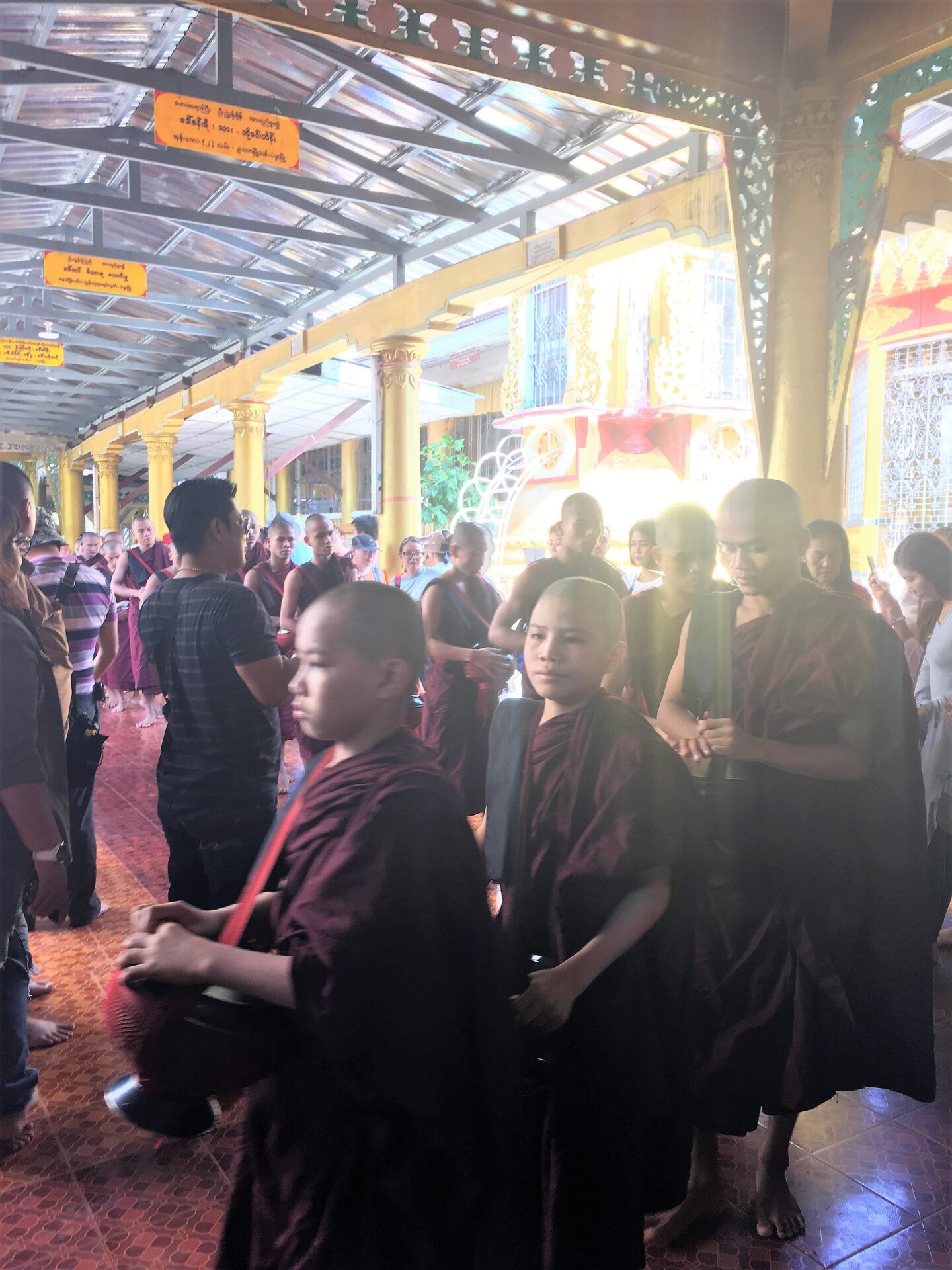
We stayed there, observing the stream of monks, trying to make as little noise as possible. There were a few tourists, taking pictures and observing the whole scene. Once the queue was finished, we kept walking until we arrived to the dining room. All the monks that we had previously seen queuing up were now sitting down at tables having lunch. And that food they were eating was the last solid piece of meal they would have for the day… And we complain about our lives 😅.
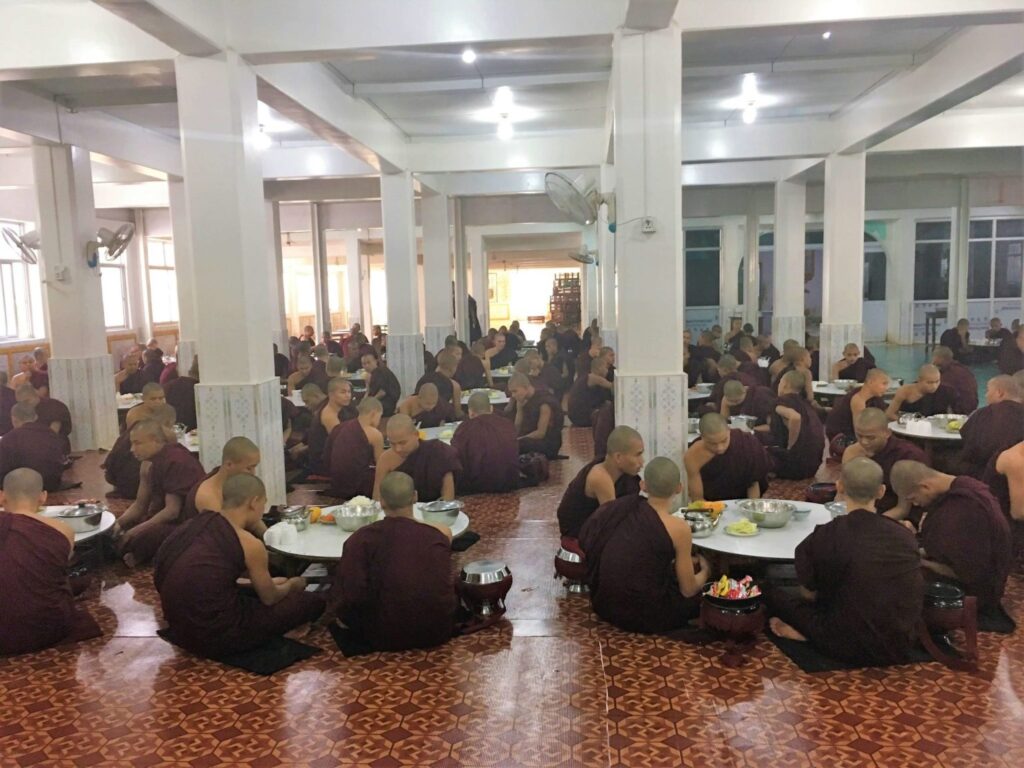
Shwemawdaw Pagoda
After the peculiar and special visit to Kyakhatwine Monastery, it was turn for the tallest stupa in Myanmar. Yes, you read well. Although often mistaken, the tallest stupa is the one of Shwemawdaw and not the one of Shwedagon in Yangon. The stupa of Shwemawdaw Pagoda has a height of 114 meters, while the Shwedagon one has a height of 98 meters. By the way, pagoda and stupa are two different things. The first can be defined as the temple or place where the stupa resides, while the second is a bell-shaped structure which contains religious relics such as Buddha’s hair or tooth.
Zo, my driver, was a kind guy. But he was not very talkative. Every time we arrived at a new sightseeing spot, he would wait outside, resting. On the one hand, that allowed me to spend (kind of) as much time as I wanted in a place. On the other hand, other than checking out the place, taking some pictures an meditating on my own, I didn’t get much info about what we were seeing. But we can’t have it all in life, can we? 🙂
We started to distinguish the silhouette of Shwemawdaw Pagoda from far away. It was really tall! The entrance was flanked by a couple of leogryphs, just as in Shwedagon Pagoda. Likewise, there were quite a few stairs before getting to the platform where the stupa resided. But, compared to Shwedagon Pagoda, there were way less souvenir stalls.
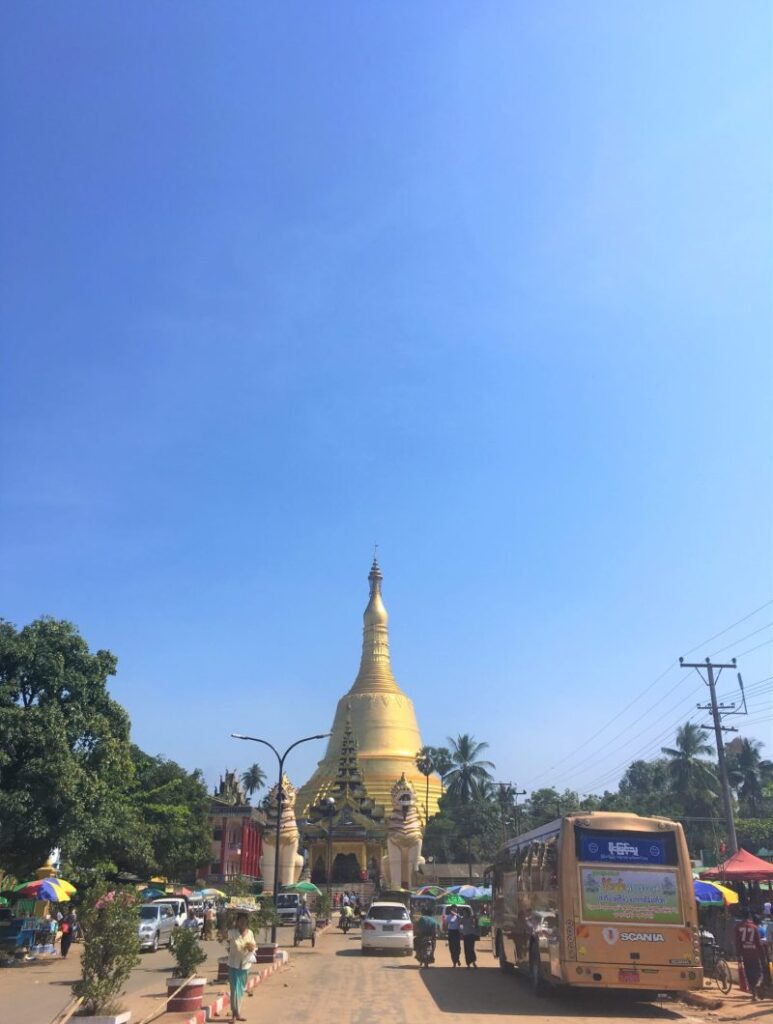
While the exact date of its construction is unknown, it is estimated that it occurred somewhere around the 10th century. The original form has been almost lost, due to earthquakes and official patronage. There are a couple of legends behind the Pagoda: one states that it was built to hold two hairs of the Buddha which were brought to Bago from India, the other one says it wasn’t two hairs but a tooth which was extracted from the Buddha’s ashes and brought to Thaton, a town I would stop in later on.
The stupa was impressive and it had an intense golden glow. The word “shwe” means gold in Burmese and it is used to represent something of a great value. Throughout my 3 weeks in Myanmar I saw plenty of “shwe” stuff. So, now you understand while the tallest stupa of Myanmar looked like this:
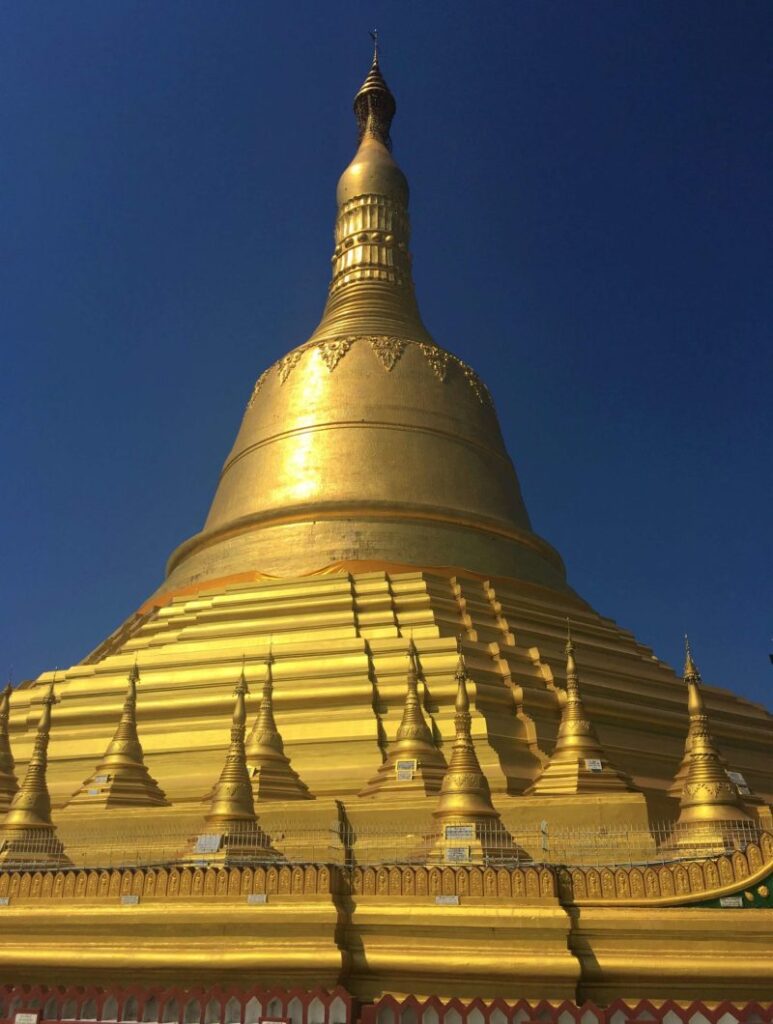
While the stupa is taller than the one at Shwedagon, the whole area is way smaller. There were other shrines within the platform, but nothing to do with what you can find at Shwedagon Pagoda. I liked the area and the pagoda itself and, while there were some people, there were way less than in Shwedagon. Thus, if you feel like Shwedagon Pagoda is too crowded, Shwemawdaw Pagoda might be your place 🙂
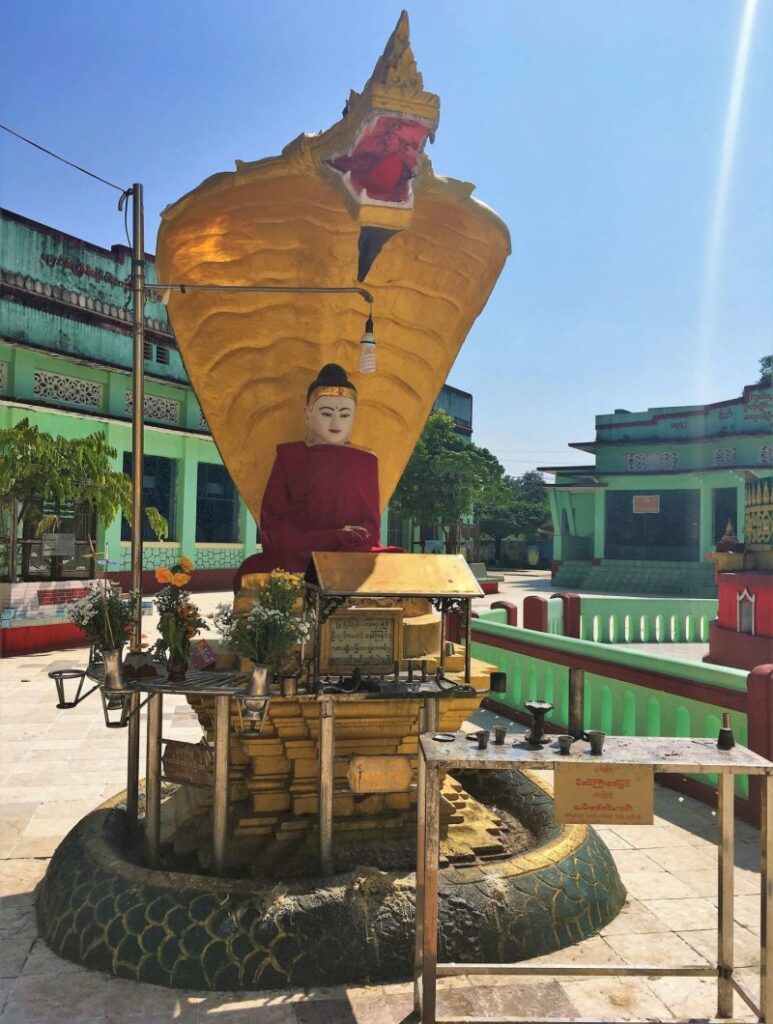
Hintha Gon Paya
The third stop of our tour in Bago was Hintha Gon Paya. If you do some research, you won’t find much info about it. It is not one of the most-well known places in Bago but I thanked Zo for taking me there. While the paya (or pagoda) itself wasn’t very impressive, since it was placed up on a hill, the views were amazing. From up there I was able to spot the lush vegetation of Bago, with plenty of palm trees. There were also plenty of pagodas, being the most distinguishable one Shwemawdaw Pagoda. It looked like this:
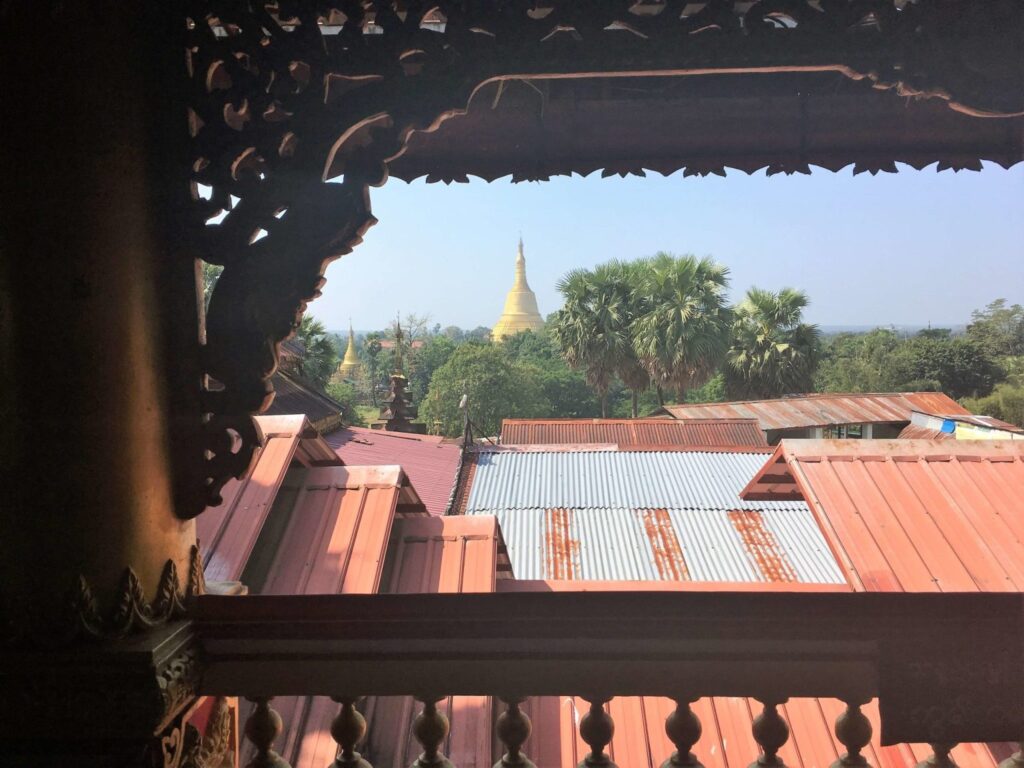
Snake Temple
After enjoying the astonishing views for a while, I walked downstairs to meet Zo once again. I jumped on the back of his motorbike and he drove to our next stop: the Snake Temple. The “temple” wasn’t like the other ones. It was more like some sort of a small room with little shrines. When I made it to the entrance, I saw a few people with their heads leaning downwards, like if they were taking a look at something. I got closer and then… I saw the largest snake I’ve ever seen in my whole life. And, apparently, I wouldn’t be the only one, since the snake is supposed to be one of the largest in the world.
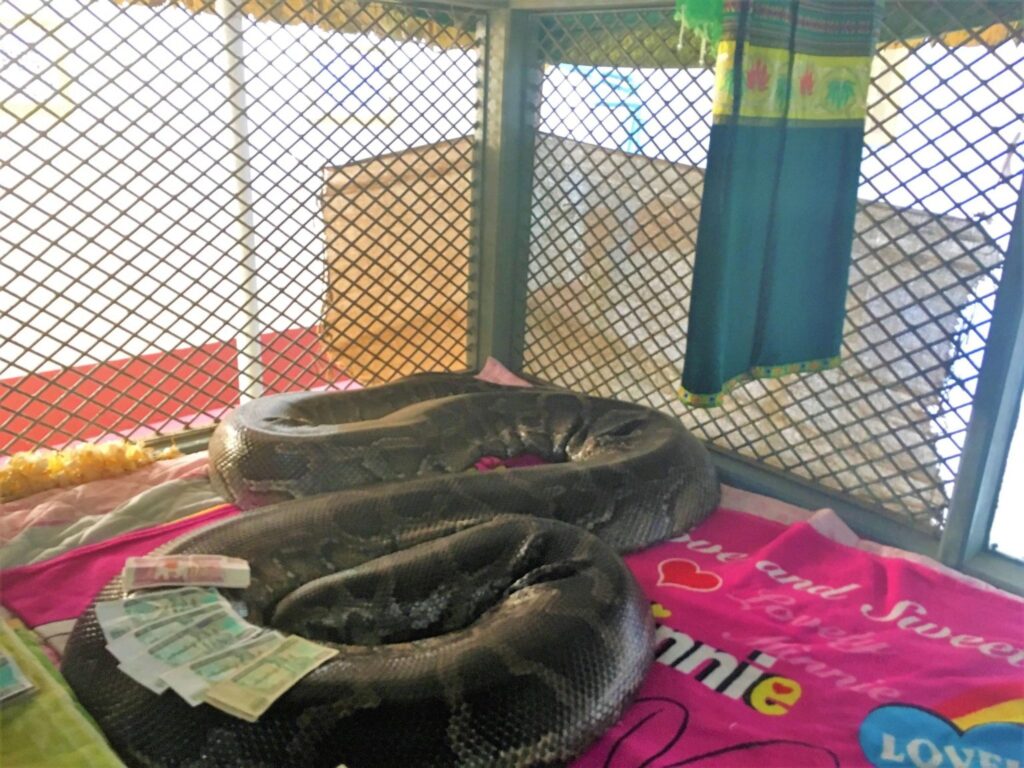
There wasn’t much to see other than the python. And I’m not saying the python wasn’t enough, but I didn’t like the show behind it. The snake is pretty old (supposedly around 125 years old) and it has a length of around 6 meters. The legend says it is the reincarnation of a monk, and people leave money as a way to have good luck. I feel like animals should be in the wildness, not like this python, which is used both as a luck charm and a way to entertain people. Thus, if I had to go back to Bago, I wouldn’t visit the Snake Temple.
Kanbawzathadi Palace
The fifth stop of my visit to Bago was the Kanbawzathadi Palace. The original palace was built in 1556. It consisted of 76 apartments and halls and it was built for King Bayinnaung. The palace’s construction took place in a very prosperous time in Burmese history. The King was one of Burma’s greatest rulers. He possessed many white elephants, a sign of wealth and power at that time. Records written by European visitors to the city tell about the magnificence and splendour of the richly gilded palace. Some of its buildings like the Great Audience Hall were roofed with gold plates.
The palace was looted and burnt down in 1599 during armed conflict. Its remains were abandoned until late 20th century. Excavation works started in 1990. Six mounds were excavated, revealing the brick foundations of the palace buildings. Several hundred of the original teak pillars used for the construction of the palace in the 16th century were found, many of them inscribed with Mon texts, as well as nearly 2,000 Buddha images.

As of today, Kanbawzathadi Palace, whose reconstruction finished in 1992, doesn’t contain much of the original furniture and personal items used by the Royals. There are several reproductions on display like the King’s golden coach, the Great Audience Hall and the Bhammayarthana Throne Hall. There is also a museum on the palace ground which exhibits items and artifacts found during the excavation, as well as information about the history of the second empire.
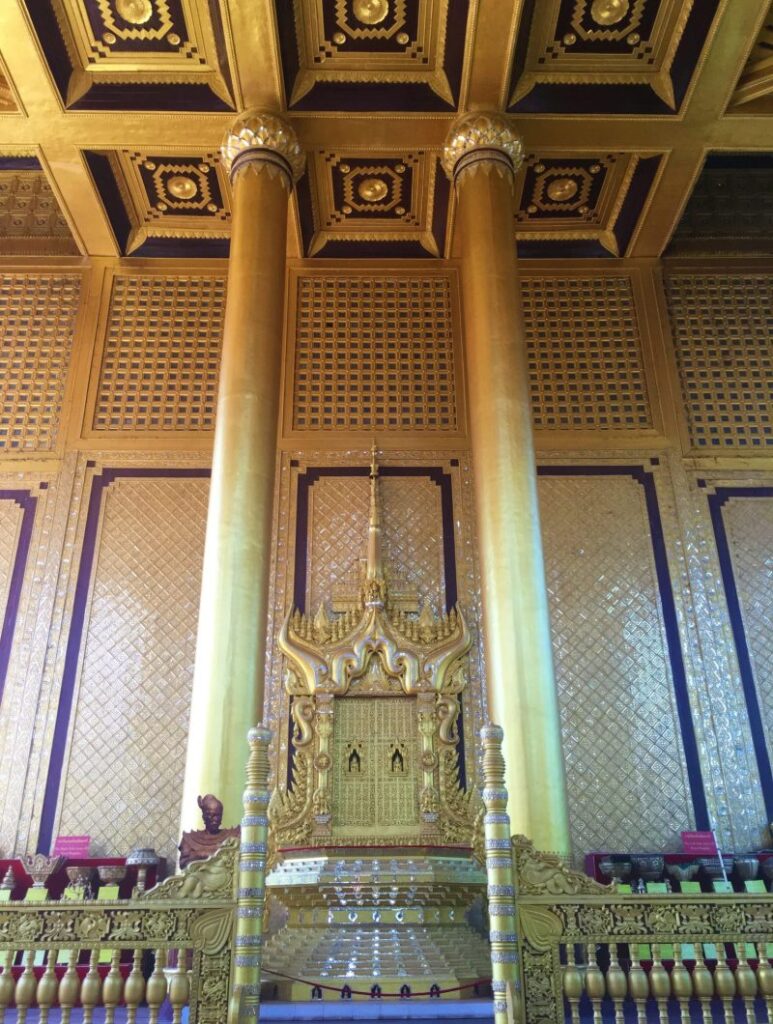
Maha Kalyani Sima
This temple is found right in front of the Mya Tha Lyaung Reclining Buddha. It was originally built in 1476 and, like almost everything in Bago, it has been destroyed and rebuilt many times. There are 4 tall standing Buddhas along with some smaller ones. The Buddhas statues are recoloured and the name of the ones helping on it are written on a plate.
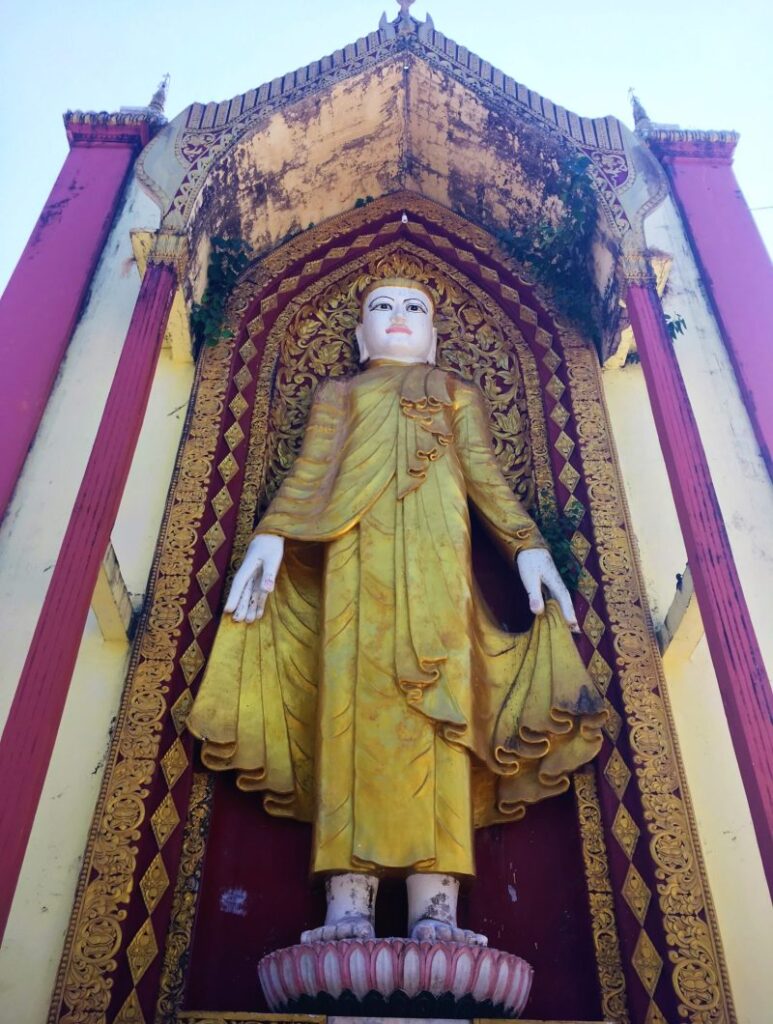
In a covered shed behind the main hall there are 10 large tablets with inscriptions in Pali and Mon describing the history of Buddhism in Myanmar. Unfortunately, I couldn’t understand anything. Thus, once again, if you want to get to know as much as possible about the history behind the buildings you visit in Bago, it might be worth it to hire the services of a tour guide.
Mya Tha Lyaung Reclining Buddha
Since Maha Kalyani Sima was right next to Mya Tha Lyaung, this time, instead of riding the motorbike, we just walked there. It was the 7th stop of my tour and one of the highlights of my visit to Bago. I had already seen a “big” reclining Buddha. Or that’s what I thought. The one in Bangkok has a length of 46 meters. I remember back then it wasn’t an easy task to take picture with it. Well, what do you think about taking a picture of a 82-meter reclining Buddha?
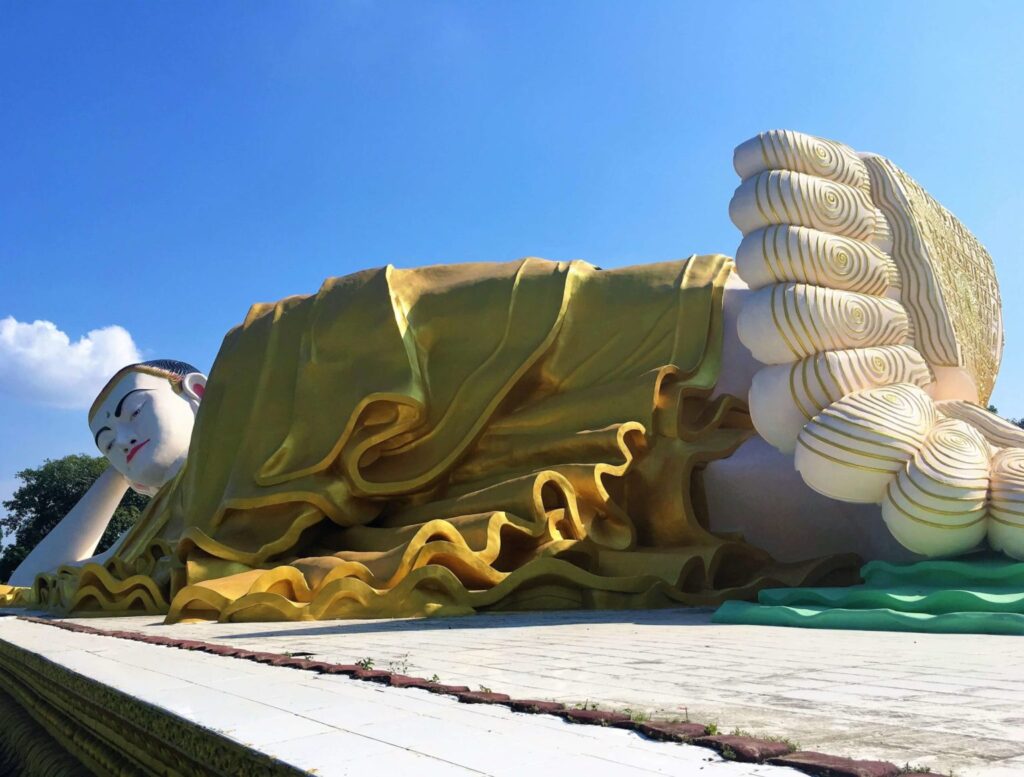
The entrance to this masterpiece is free. The area around is kind of empty, so it is “easy” to take pictures of it. Myanmar is a country where around 80% of its population is Buddhist. There are probably millions of Buddha statues in the country, but not many with such a size. As I was staring at the statue, I tried to imagine the efforts that it took the Burmese people to build such a giant. Not an easy task, huh?
The reclining position represents the final phase of Buddha’s life, right before entering parinirvana. It is believed the statue was built in 2001 by the contributions of Burmese people. I wouldn’t be surprised if that was the case. The statue looked pretty new, don’t you think? The sole of his feet were covered on detailed golden reliefs. They were probably the most beautiful feet I’ve ever seen 😄.

Right next to the huge statue there was some sort of a pond with a shrine. I walked to it and it was then that I saw one of my favourite Buddha statues during my whole 3 weeks in Myanmar. It was my second Naga Buddha (the first one was at Shwemawdaw Pagoda) and it wouldn’t be the last one. But I really enjoyed this one. What do you think?

By the way, “naga”, in Hinduism and Buddhism, is the Sanskrit word for a deity taking the form of a great snake. The Buddhist naga has the form of a great cobra, usually depicted with a single head. The naga which is seen sheltering the Buddha while meditating is known as Mucilanda. Mucilanda is believed to have protected the Buddha from a storm as he was meditating under the Bodhi tree, right before he attained enlightenment.
Shwe Tha Lyaung Buddha Reclining Buddha
Not sure why they built it that close from one another but, after a few minutes walking, we arrived at yet another huge reclining Buddha: Shwe Tha Lyaung. This one though was a little smaller, with a size similar to the one in Bangkok. It is believed to have been built in 994, during the reign of Mon King Migadepa.

It was lost during a loot in 1757 and it would remain like that for almost 120 years. During British colonial rule, as they were building a railway between Yangon and Bago in 1880, they rediscovered it under a cover of jungle growth. Restorations began right after its rediscover, and other details such a mosaic pillow were added in 1930.

Unlike Mya Tha Lyaung, the entrance to this monument is not free, but it is included in the “Bago Archeological Zone” ticket of 10 K. The statue is surrounded by pillars, small shrines and other decoration, which makes it difficult to get a proper picture. There were people praying and somehow it felt more crowded than Mya Tha Lyaungbut. Thus, if you asked me, I would say I liked the largest Buddha better 🙂
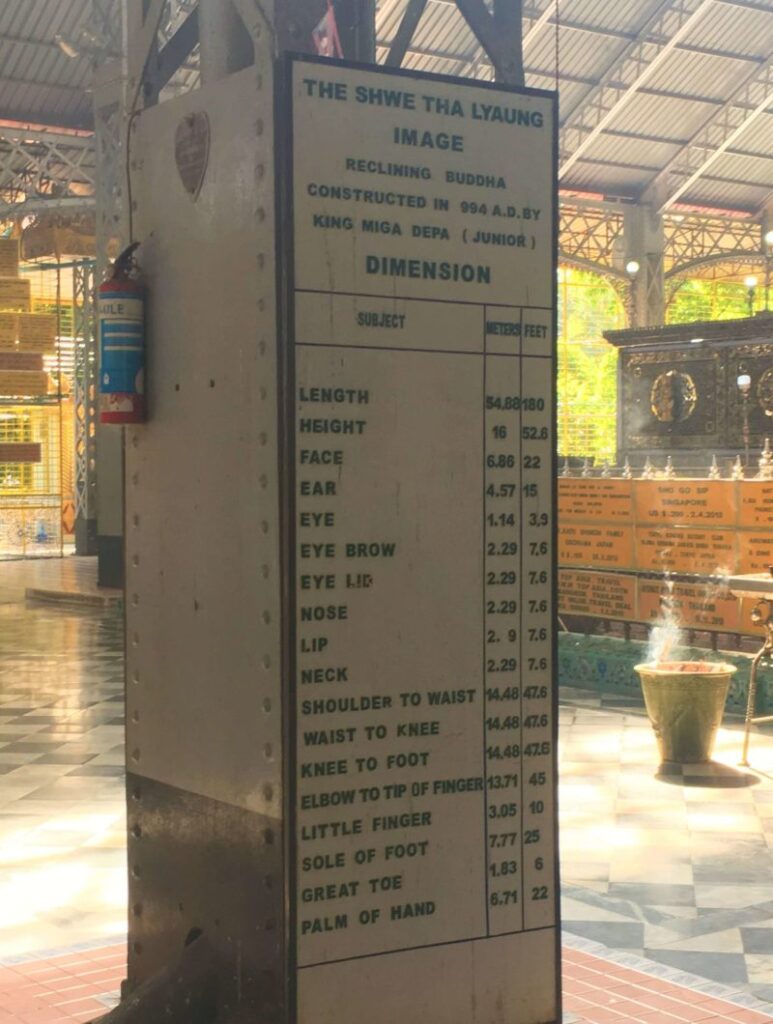
Shwegugale Pagoda
After the two huge reclining Buddha statues, it was turn for Shwegugale Pagoda, a pretty peculiar place. The Pagoda was kind of mouldy and old-looking but the beauty is supposed to be inside, isn’t? Shwegugale Pagoda was built in 1494 under the reign of King Byinnya Yan. I guess if I told you it had been rebuilt several times you wouldn’t be surprised by now, would you? 🙂

Unlike other temples, the stupa has a circular tunnel that allows you to circle it. As you walk around it, you will see a total of 64 Buddha statues. They are not very impressive or sophisticated, but they are not meant to be. The whole stupa and its Buddha figures are designed to be simple but to contain a high level of reverence and sacredness. The statues, which have a size similar to a person, have all the same design. The temple is kind of isolated, with no parking lots, souvenir shops or food stalls, which makes it an ideal place to enjoy the spiritual and calm atmosphere.

Kyaik Pun Paya
The last stop of my visit to Bago was Kyaik Pun Paya and, I had to say, it was one of my favourites pagodas. As always, I was sitting on the back of Zo’s motorbike, who throughout the whole tour around Bago had shown himself as a calm and quite person. I asked him what he liked and he told me he didn’t like anything. He didn’t like sports, alcohol, party or women. He saw me meditating a few times and told me he also did it. When I asked him for how long he normally meditated he said he didn’t know it. He just never gave importance to the duration of his meditation sessions. On the other hand, his younger brother loved mobile phones lol.

Kyaik Pun Pagoda was built in 1476 by the Mon King Dhammazedi. Inside the pagoda there are 4 impressive sitting Buddha statues. They have a height of 27 meters and they all have the mudra position of “calling the Earth to witness”. This mudra is always depicted with the left hand facing upward in the lap while the right one points downward, touching the earth. This mudra is said to have been the Buddha’s hand gesture when he attained enlightenment.

The images represent the four Buddhas that have reached Nirvana, namely Kassapa, Kakusandha, Konagamana and Gautama. They sit back to back facing the four cardinal directions. The four seated Buddhas wear golden robes and all have slightly different facial expressions. The statues were really impressive and I spent a while walking around them. The pagoda was placed at an open-air space, with no shelter from the elements. The entrance fee was included in the “Bago Archeological Zone” ticket 🙂
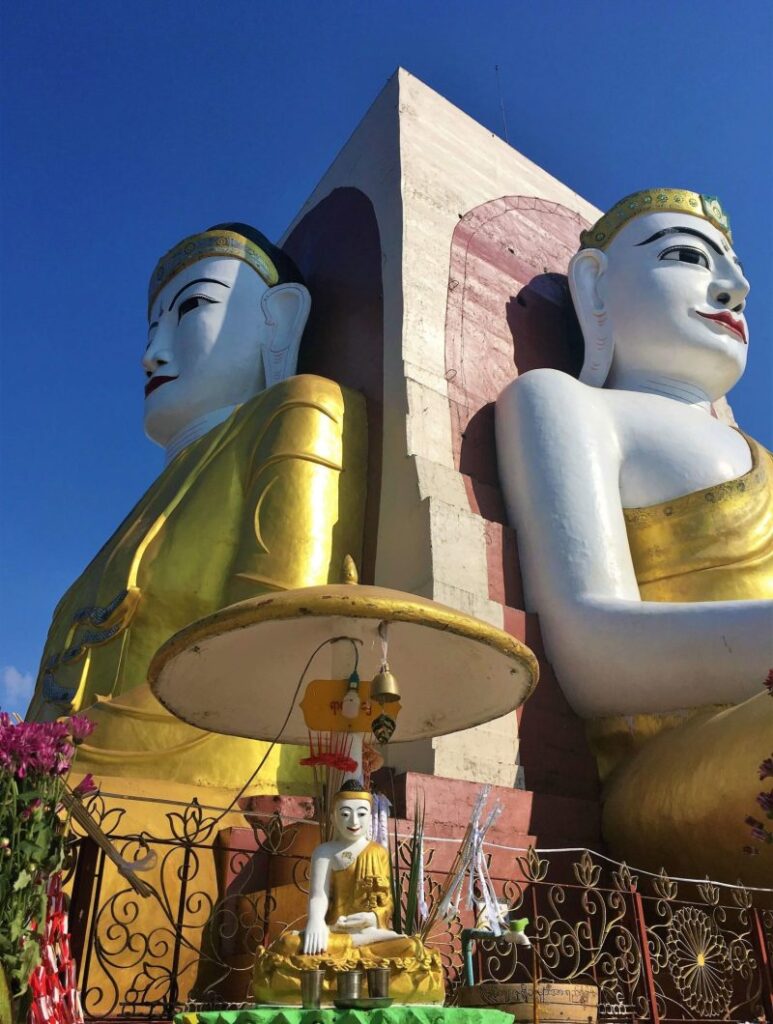
So long Bago!
We had spent around 3 hours and a half visiting the highlights of Bago and, after Kyaik Pun Paya, Zo drove me back to the restaurant where I had left my stuff. I thanked him for his time and insisted on inviting him to lunch but he didn’t agree. I felt though like I wanted to show him my gratitude for his time with something else than words and, in the end, I tipped him.
The restaurant was quite big and the people working there were very nice. I ordered stir fried rice vermicelli noodles, something which I had never tried before and it was a great choice. Compared to other noodles they are extremely thin. Like any stir fried rice dish, you could have it with meat and/or vegetables. I went for the veggie option and they were delicious. The shape and size made a difference in the taste!

From Bago to Hpa-An
I had been waiting for almost an hour at the restaurant when they told me that, apparently, there was no bus to Hpa-An. What?! It seemed that due to a celebration or a festivity the straight bus from Bago to Hpa-An wasn’t running that day. Remember when I told you before that it wasn’t that easy to get my bus ticket to Hpa-An? Everybody told me the bus was leaving at a different time and others said that there was no bus running that day. I paid 7 K for the bus ticket, which is nothing but, money aside, it seemed my chances to get to Hpa-An that day were not very high.
As I was looking for a hostel in Bago, the people at the restaurant hasted me to take my stuff and walk outside the restaurant. Were they kicking me out? No. They had been talking with someone on the phone and they kind of forced a bus to stop and told me to jump in. I didn’t even know where the bus was going! Everything happened pretty fast but, apparently, the bus would take me to Thaton, a town an hour away from Hpa-An. Once there, (they said) it should be “easy” to find a bus which would take me to Hpa-An. I didn’t have many choices so I just jumped in.

The bus was super crowded. There were people standing up and others sitting on some sort of foldable seats which were all in the middle of the bus alley. I got one of that myself and, after an hour or so, as people started to get off the bus, I moved to a regular one.
I was super tired but couldn’t sleep much. The bus ride felt kind of long. We stopped at a restaurant for dinner and, after around 4 hours, we arrived in Thaton. The city was fully decorated with plenty of lights. I even saw some lanterns but they were just laying there and not flying in the sky :/. The bus stopped at a “bus station”, if we can call it that. It was just a piece of soil with a couple of bars, buses and vans. The views from there were pretty nice though, as I could see a beautiful golden pagoda shinning under the moon’s glow. It looked like this:

I walked around and tried to find some info about the bus from Thaton to Hpa-An but there was none (or I couldn’t understand it). I asked some people there but the language barrier showed up once again. It wasn’t easy to communicate with them and I was told very different things. First, they told me the next bus was coming at 21:00. Then, they said it was coming at 23:00 and, eventually, they said there was no bus. The nightmare was reoccurring.
I didn’t digest that last piece of information very well. I felt upset and frustrated but there wasn’t much I could do. Therefore, I started to look for a place to sleep but there were not many options and they were kind of expensive. I decided to change my approach and take a break for a while so I walked to a nearby bar an ordered a tea and some pastries. And… my luck changed.
Among all the people who were waiting there, there was a kind guy who could speak some English. He told me he was waiting for his friend and then they would be driving to Mawlamyine or somewhere around. He asked me why I didn’t try to get a hostel and, when I told him prices were kind of high, he agreed and said that was the reason why he was sleeping in his van lol.
During the time we were talking, some taxis and tuk-tuk approached me and told me they would take me to Hpa-An for 15 K. They didn’t give me a good feeling and I rejected their offer. My friend agreed with my reaction and said that sometimes some of those guys worked like mafias and you couldn’t know if they were good or bad. It all seemed lost when… the magic happened.
He stopped a random truck which was passing in front of us and asked them if they were driving to Hpa-An… And they said yes! They answered the same way to his question on whether they would take me there for 3 K. And, “just like that”, I sat on the back of a truck full of sacks full of I didn’t know what heading for Hpa-An. I thanked several times my friend as the truck was retaking its way and we were leaving the “bus station” of Thaton behind.
It was pretty dark by then so I almost got a heart attack when I discovered there was someone else on the back of the truck. Apparently, he was working with the guys driving and he was there just “chilling”. The sacks were pretty uncomfortable but I was so tired that I even fell asleep. I didn’t know where we were, whether I could trust those people and whether I would arrive in Hpa-An. But, would thinking about all those things change the outcome? No 🙂
So, how did you like Bago? Have you ever been there? Did you get to visit another place which I haven’t mentioned here? What was your favourite highlight? Did you hire the services of a tour guide who would explain everything about the history behind the places you were visiting? Was it worth it? And, more importantly, do you think I made it to Hpa-An? You’ll have to wait to the next post to find out 😁
